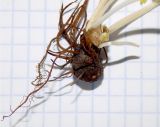| Дмитрий Орешкин | Янис Рукшанс пишет:New name applied for former Anemone blanda from Russian Caucasus - Anemone banketovii Rukšāns - in International Rock Gardening. See: http://www.srgc.org.uk/logs/logdir/2018Nov291543526367IRG107-November.pdf
http://forum.plantarium.ru/viewtopic.php?id=81905 |
| Анна Малыхина | Поздравления Сергею Банкетову!!!
Из этой статьи следует, что у нас Anemone blanda не растет, а вместо неё растет Anemone banketovii.
Не понятно только как их различать, только копать???, как следует из этого ключа:
1 Underground tubers small, around pea-size, roundish…………………A. caucasica
1. Underground tubers elongated, branch-like, up to 9 mm in diameter.…A. banketovii
1. Underground tubers knobbly, large and irregularly shaped roundish
2. Leaves hairy beneath, fruiting heads erect …………………….A. apennina
2. Leaves glabrous beneath, fruiting heads nodding ………………..A. blanda
Но ведь встречаются взрослые экземпляры с крупными (гораздо больше 9 мм в диаметре) и не совсем удлиненными корневищами. Их куда? Для гербаризации обычно выбирают растения которые легко поместятся в прессе, то есть не самые пышные и крупные. По моим наблюдениям, чем взрослее растение, тем округлее и крупнее у него корневище.
Ещё один момент: в списке использованной литературы некорректно указаны авторами красных книг Краснодарского края, Ставропольского края, Северной Осетии редакторы списков краснокнижных растений здесь, в Плантариуме. Я не являюсь автором красной книги Краснодарского края. |
| Янис Рукшанс | Even in cultivation Anemone banketovii keeps the shape of tuber for years and always resembles branches (thicker or thinner - not so important), regardless - replanted every year or grown untouched for several yerars. I'm growing it since 80-ies of last century and from the very start regarded it as different from A. blanda (at first by its isolated area, in this following Yuzepchuk) and my opinion was confirmed when I got authentic A. blanda from Turkey. There are many plants (Crocus, many Tulipa etc.) where you can identify species only after checking of underground parts. In Gagea you must to check seedlings and their development for correct identification of species etc. So, yes, if you don't know origin of your plant and want to identify it - you must dig it out and check tuber, corm, bulb tunics, cataphylls etc. etc.
Serious botanists are making herbariums from typical plants, not selecting aberrations from normal. Herbarium is type specimen, characterising species, its etalon!
Some Red Data books were cited from Plantarium and there could be mistakes in authors, I agree with this. It is quite difficult to get now originals of post-soviet Russian literature here, especially being retired and living far from cities. |
| Сергей Майоров | Обнародование действительно, но насколько эффективно?  Даже GOOGLE пока этот вид не ловит...  |
| Анна Малыхина | Здесь видны и удлинённые и округлые корневища   . И это растения природные. |
| Николай Степанов | Мне видится, что во втором случае растение просто молодое. Это может быть отломившийся фрагмент от более старого. Еще не дорос  |
| Николай Степанов | |
| Анна Малыхина | Растение уже цветущее.  |
| Николай Степанов | Цветущие растения тоже бывают разного возраста. Надо понаблюдать за растением с шаровидным корневищем. И года через 2-3 вновь выкопать и посмотреть. Форма и размеры должны измениться. |
| Янис Рукшанс | Citation from Facebook page of Dimitri Zubov (botanist, who published new Galanthus panjutinii from Caucasus): Наталья Заручейская пишет:Все, я поняла, это та анемона, о которой я тебя спрашивала "почему два вида называют одним именем - anemone blanda" |
| Анна Малыхина | Николай Степанов пишет:Цветущие растения тоже бывают разного возраста. Анна Малыхина пишет:По моим наблюдениям, чем взрослее растение, тем округлее и крупнее у него корневище. |
| Янис Рукшанс | I'm growing it for more than 40 years, It always formed only branch-like tubers. On picture (in article) are tubers of pot grown plants and even those are around 40 mm long and thin, but those in garden are even longer, but difficult to get out without breaking. Pot grown plants are well fed, so they are thicker, too, comparing with those grown in "wild-like" conditions. Round tubers has Anemone blanda and hybrids, but all this is mentioned in publication.
Actually I always was surprised why no one published it before me. The differences are so clear and well expressed. For me it was not so easy to prepare this paper as I'm working on crocuses, but after publishing of my monograph "The World of Crocuses" (568 p., ~1700 colour pictures, 235 species described in details) I had some free time and needed some rest out of crocuses, so started to work on new taxa gathered during my gardening life (60 years) from other genera. |
| Сергей Майоров | Николай Степанов пишет:...GOOGLE пока не успел 
Часто роботам хватает суток.  |
| Анна Малыхина | Так я не поняла, у нас, на Маркотхском хребте, район Анапа -Новороссийск-Геленджик оба вида (A. banketovii и A. blanda) что-ли растут и гибридизируют??? |
| Янис Рукшанс | Анна Малыхина пишет:Так я не поняла, у нас, на Маркотхском хребте, район Анапа -Новороссийск-Геленджик оба вида (A. banketovii и A. blanda) что-ли растут и гибридизируют???
No, in Caucasus are only A. banketovii and A. caucasica. Hybrids occur in cultivation if plants of A. banketovii from "Russian" Caucasus and A. blanda from Turkey (or Dutch cultivars) are grown side by side. |
 Даже GOOGLE пока этот вид не ловит...
Даже GOOGLE пока этот вид не ловит... 




